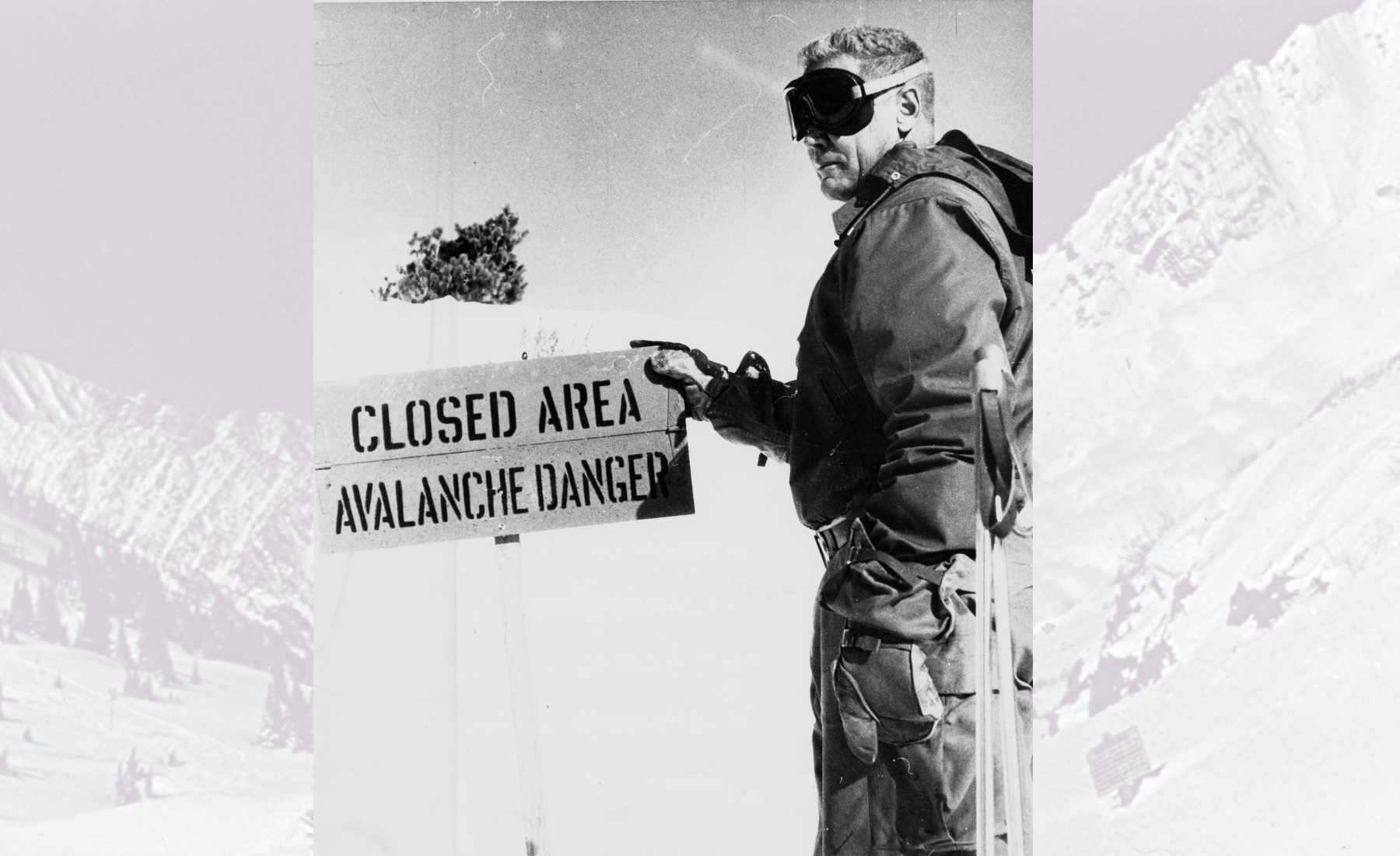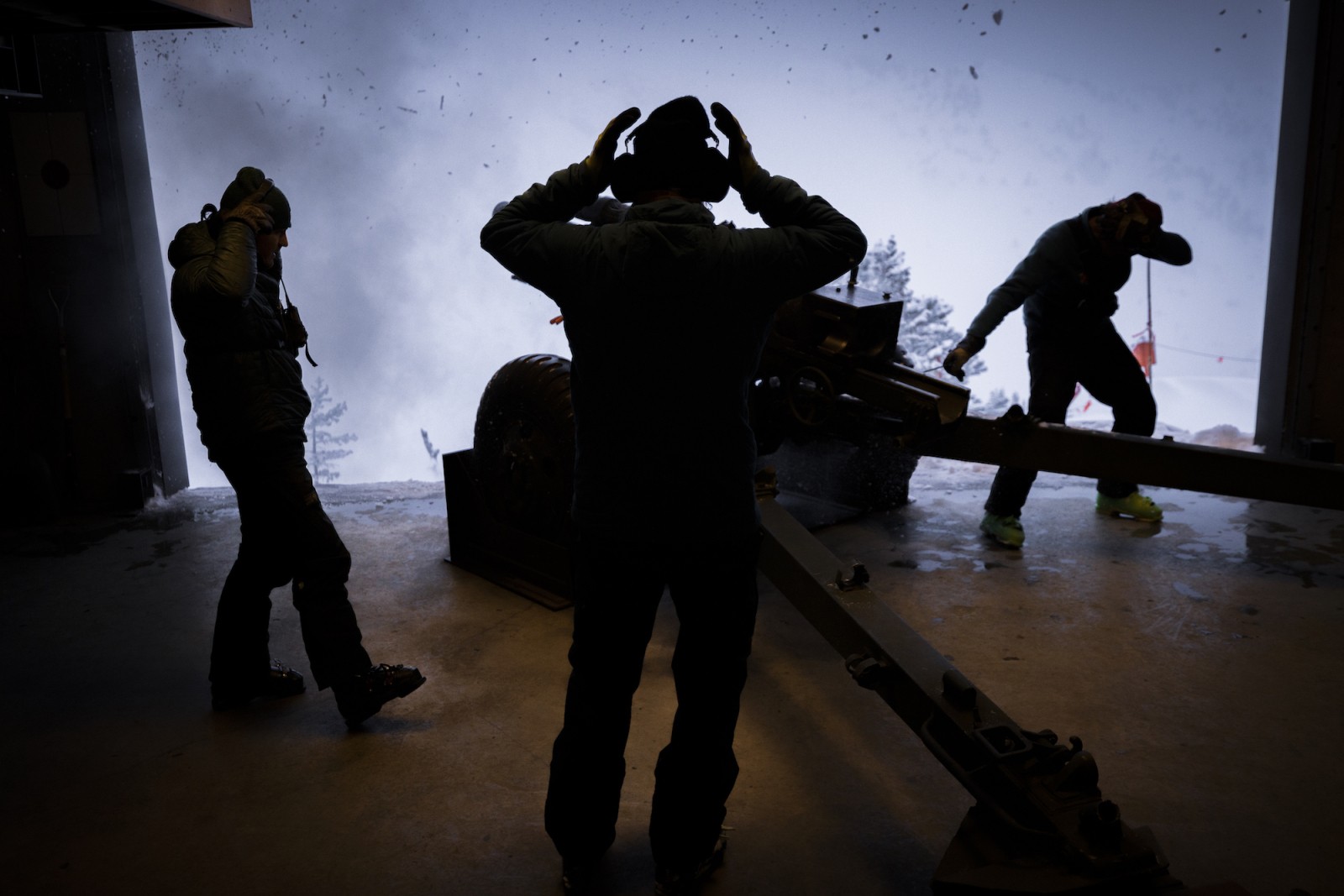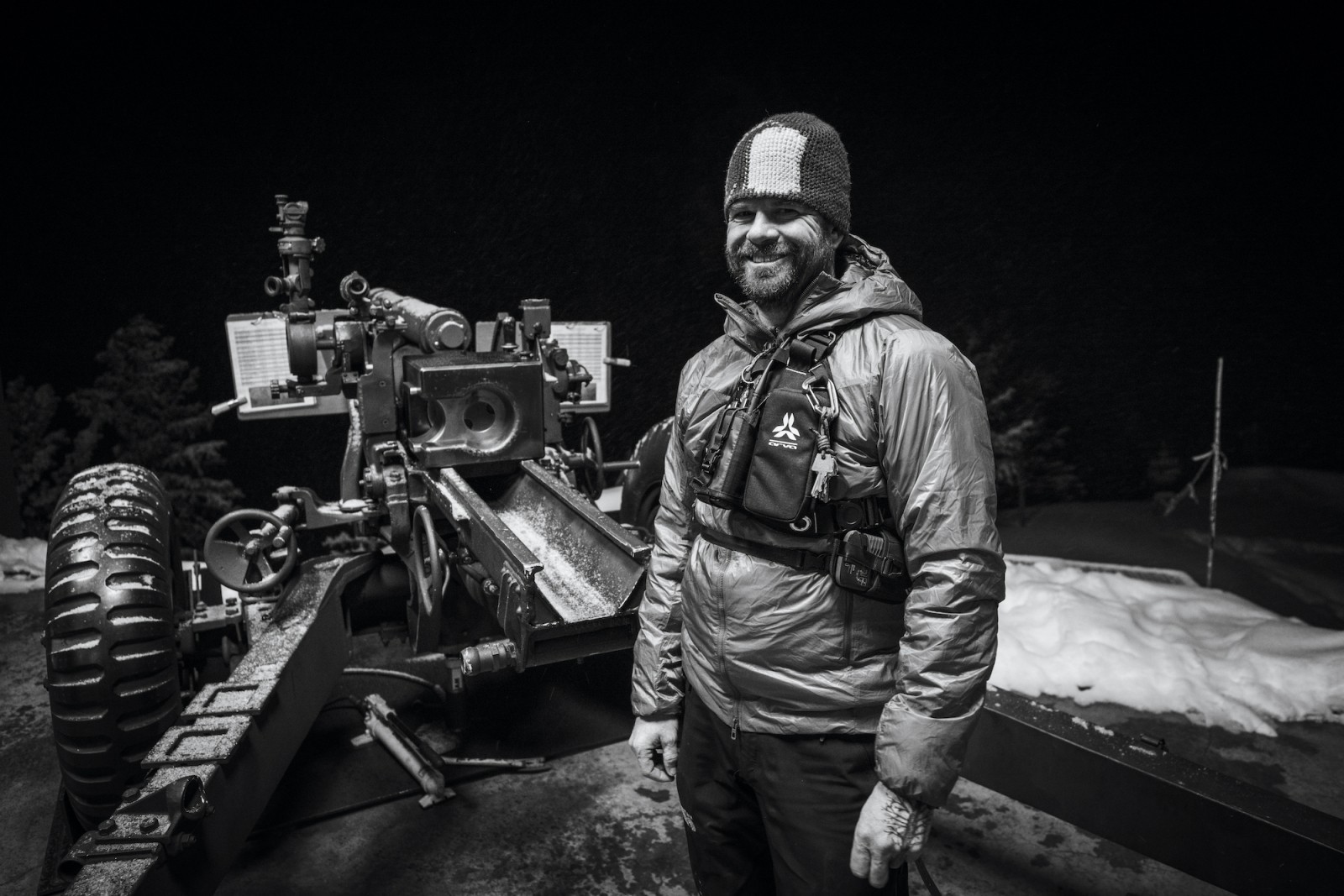Alta Ski Area was the second ski area in North America to load intrepid skiers onto a chairlift on the 15th of January in 1939. As the trials of the Great Depression eased, the United States Forest Service (USFS) had contracted legendary Norwegian ski champion, Alf Engen, to survey the mountains surrounding Salt Lake to identify possible sites for skiing and recreation.
At the time, the slopes at the top of Little Cottonwood Canyon were bare and denuded, having been ravaged for decades by miners hoping to strike silver lode. Engen's ability to dream big proved prescient when he recommended this blighted landscape for what would become Alta Ski Area.

Alta - Late 1800s looking at the Wildcat and Westward Ho area
Alan Engen Ski History Collection
The lack of timber and the prodigious snowfall created a unique avalanche problem and one that had already claimed the lives of over 85 people in some 14 slides around the Town of Alta between 1872 and 1927. With over 500 inches of snow typically falling at the head of Little Cottonwood Canyon each winter, the inevitable result is massive, deadly, and wildly destructive avalanches. Personnel at Alta Ski Area and the USFS rapidly realized they were no match for the clouds of thunderous snow that could demolish chairlifts, bury skiers, destroy buildings and close the highway for days or weeks at a time.
Something had to be done if Alta Ski Area and the town were to survive...

1885 Avalanche destroys town
Photo generously provided by the Utah Department of Transportation
Sverre Engen, the brother of Alf Engen, was busy helping Alf to run the ski school when he was hired on as the area's first USFS Snow Ranger. Sverre diligently perfected his mastery of the ski cut as he tested out avalanche-prone slopes before allowing skiers to enjoy the fresh snow. Sverre experimented on smaller, less consequential slopes at first and then began digging snow pits to study the layers that formed in the snowpack between subsequent storm events. The data and observations he gathered helped Sverre begin to predict which conditions produced dangerous avalanches.

Alan Engen Ski History Museum - Alta Historical Society
Around 1941 the Alta Ski Patrol was created, but at the time, the study and management of avalanche hazards was relegated to the USFS Snow Rangers. Sverre began dabbling in testing out various explosives to trigger avalanches following snow storms. This was preferable to him venturing out on dangerous, loaded slopes while ski cutting. It wasn't until the succession of Sverre by Montgomery (Monty) Atwater in 1946 that the avalanches of Alta would discover a worthy foe.

Monty Atwater, USFS Snow Ranger
Special Collections, J. Willard Marriott Library, The University of Utah
Atwater had been discharged from the 10th Mountain Division in WW2 after suffering an injury. He had witnessed the Swiss protecting their towns with mortars and bombs and as the 3rd USFS Snow Ranger at Alta Ski Area, he brought a steadfast sense of curiosity and a pioneering spirit to the rapidly growing knowledge base of avalanche and snow science..jpg/inline-display)
Monty M. Atwater checks weather instruments at Alta's rudimentary weather station
Utah State Historical Society
"Nowadays the distant thud of avalanche bombs and projectiles is so familiar a sound in skiing that skiers hardly look up from lacing their boots. It was not so in Alta in 1948."
- MONTY ATWATER
Monty Atwater tosses a hand charge into the High Rustler ski run
Special Collections, J. Willard Marriott Library, The University of Utah
Atwater began testing out various types of explosives and hand charges, making detailed and careful observations after each storm. He hoped to regularly trigger and release smaller avalanches after each snowstorm to avoid the huge and destructive avalanches that plagued the area in earlier days. By drilling holes into overhanging snow and cornices along ridgelines, Atwater discovered he could detonate explosions electronically to cause snow slides. A maverick, he was seldom seen without a cigarette drooping from his lip as he handled dangerous boxes of explosives, fuses and tetrytol.
"To an ex-infantryman the answer was obvious: fight the avalanches. The means? Explosives."
- MONTY ATWATER
1948, Atwater rigging explosives around Peruvian Ridge at Alta Ski Area
Special Collections, J. Willard Marriott Library, The University of Utah
"Hand blasting was very effective, but it still took too long. There were conditions, like the middle of a blizzard, when it was too dangerous to be scrambling around on Rustler Face, Lone Pine, Stone Crusher and the like. There were more skiers. They needed more room, faster. The Germania Lift was in the planning stage. That would put skiers within reach of a playful swipe from Baldy, a target we couldn’t reach on foot at all. I wanted artillery. What infantryman doesn't?
The proven success of stalking avalanches on foot and stuffing explosive calling cards down their throats gave me courage to make my next proposal..."
- MONTY ATWATER
In late March of 1949, Atwater won a massive battle when he finally gained permission to conduct a groundbreaking experiment at Alta. The Forest Service Supervisor, Felix C. Koziol, and the Utah National Guard approved Atwater's outlandish proposition to perform a test fire to shoot avalanches at Alta with a French 75-mm howitzer gun.
Captain Elkins of the Utah National Guard volleyed fifteen shots from the highway in front of the Forest Service Garage. Five slides resulted as the weapon was manned across a 180-degree span from Patsy Marley Ridge to the east, through Eagle’s Nest, High Rustler, Lone Pine, Mount Baldy and finally the Peruvian Ridge. Atwater wished to eliminate the immense time, effort and hazard required to hike explosives and hand charges to Alta's multitude of avalanche start zones. What the 75-mm howitzer rapidly accomplished from a single position would have taken a Snow Ranger three days of backbreaking work. Atwater's gamble was deemed a huge success.

Deseret News, March 30, 1949
The following winter the Utah National Guard's cannon and ammunition were stored at Alta. Atwater was to provide 24 hours of notice to the Guardsmen to allow them time to make plans and travel up the canyon's highway to shoot the artillery. There were drawbacks to this protocol as the gun was most needed in the heart of the storm when the road would often be closed and travel from Salt Lake City to Alta was all but impossible. National Guard gunners would often face delays of 12 hours or more, negating the advantage of fighting a storm in real-time.
During the third winter with artillery, Captain Elkins suggested Atwater consider shooting the gun himself to prevent the hassle of running Guardsmen up and down the treacherous canyon road in foul weather. After a particularly gnarly storm that Atwater termed a "sockdolager", he fired the 75-mm without authorization to provide relief for the stir-crazy skiers who had been imprisoned inside the lodges for over 48 hours. Atwater continued to shoot the gun when needed without authorization or the knowledge of the bureaucracy until a loud-mouthed skier bragged about all the wonderful powder snow he'd enjoyed after a 15-minute onslaught by the artillery.
Atwater was busted.
Monty Atwater and Felix Koziol with a National Guard gunner at Alta
Special Collections, J. Willard Marriott Library, The University of Utah
A series of alarms and memos escalated to the top Chief's office in Washington D.C. Supervisor Koziol had his hands full defending the actions of Atwater and stressing the harrowing danger the avalanches presented. As the hysteria subsided it was determined that the USFS Snow Rangers would be permitted to shoot the gun only in emergency conditions with the blessing of the National Guard, the Governor of Utah and the United States Forest Service.
Atwater blithely determined any storm worthy of producing avalanches could rightfully be deemed an "emergency" and moving forward, the Utah National Guard gunners were not so essential to managing operations and mountain safety at Alta. The stalwart Snow Rangers learned something new each time they battled a storm and a complex avalanche safety plan and operational protocols were gradually developed.
"Those were the halcyon years. No one ever again had so much fun hunting avalanches as we did, or ever will again. We learned something new every trip out. It was a time when a gunner could jump up and down in the parking lot screaming, “Look at that S.O.B. Go!"
- MONTY ATWATER
Atwater firing the 75-mm howitzer toward Mount Superior from Highway 210
Special Collections, J. Willard Marriott Library, The University of Utah

Two men prepare to blast Mount Superior, Utah, February 1966
Special Collections, J. Willard Marriott Library, The University of Utah
In the mid-60's Alta's latest USFS Snow Ranger, Bengt (Binx) Sandahl, was keen to work more closely with Alta Ski Patrol to better understand and manage the avalanche threats at the ski area and above the highway. Sandahl dedicated himself to developing efficient routes for ski patrollers to deliver hand-charge explosives and reduce the ski area's reliance on military weapons. By 1972, the USFS formally determined that its involvement in avalanche mitigation within a private ski area was no longer feasible. The responsibility of keeping the highways and ski areas safe was handed off to ski patrols and the Utah Department of Transportation (UDOT).

United States Forest Service Photo, Circa 1940-1960
Special Collections, J. Willard Marriott Library, The University of Utah
The contemporary Alta Ski Patrol was using a M101-A1 105 Howitzer to combat avalanches and keep the ski area safe. The legendary 903-inch winter of 2022–23 tested the resilience and endurance of every individual involved in mountain operations at Utah's resorts. It was a fitting winter for the military artillery program utilized by Alta Ski Area to conclude with a bang. It took Alta Ski Patrol 30 artillery missions and 220 rounds to throttle the avalanches that vicious and unending storms dumped on Little Cottonwood all winter. With numerous extended road closures, days where the resorts could not operate, and snowbanks 30-feet tall, the stories of the 903-inch winter will be retold for decades to come.
Alta once served as the birthplace of modern avalanche mitigation and science in North America. Decades of innovation and the actions of the brave USFS Snow Rangers, Ski Patrollers and forecasters have saved countless lives.
Alta Parking Lot, Feb 6, 2023
Lexi Dowdall
It is the end of an era at Alta Ski Area when weapons of war caused a thunderous clatter in the dawn hours of stormy mornings.
For 75 years, military artillery has prevented the destruction of the highway, the town and the ski area by deadly avalanches. These hulking weapons have protected the lives of skiers who cherish making memories in one of the foremost powder skiing destinations in the world. The future of avalanche mitigation now lies in Remote Avalanche Control devices (RACs). Alta has spent the last 3-4 summers installing Swiss-made Wyssen Towers within its most notorious avalanche start zones. Once again, Alta finds itself in the crosshairs of innovative solutions and at the forefront of the next frontier in avalanche mitigation.
"I refuse to believe that this riddle is beyond the powers of a technology that can pilot an electronic gadget to the moon and then direct it in a series of complex maneuvers. The solution will not be easy, because of the recalcitrant nature of snow. It will require ingenuity, imagination, approach from new angles, and equipment that doesn’t exist. But the only real obstacle is to convince the authorities who control the supply of brains and money that this is a worthwhile project."
- MONTY ATWATER
IMAGES OF ONE OF ALTA SKI PATROL'S LAST MISSIONS - February 22, 2023
Photos courtesy of Rocko Menzyk and Alta Ski Area





WHERE TO SEE THE LAST GUNNERS FILM
"Last Gunners" will be making a series of local and international film tour stops.
Find your venue to see it on the big screen!
2024 Wasatch Mountain Film Festival: Official Selection with Q&A
September 17-22, 2024
Screening: Sat, September 21 @ 5:30PM - Info Here
2024 Wydaho Film Festival: Official Selection with Q&A
September 19-22, 2024
Screening: Thurs, September 19 @ 6PM - Info Here
2023 Mendi Film Festival: Official Selection
December 8-17, 2023 - Info Here
2023 Season Kickoff Party
Nordic Valley Ski Resort, Eden, UT
Fri, Dec 8, 2023
Alta Community Enrichment - Welcome to Winter Party
Our Lady of the Snows, Alta, Utah
Thurs, November 16th - Info Here
2023 iF3 Movie Awards - Official Selection
Whistler, British Columbia, Canada
October 18-21, 2023 - Info Here
2023 Winter Park Film Festival - Official Selection
Winter Park, Colorado, USA
Sept 8-9, 2023 - Info Here
Video produced in partnership with Alta Ski Area.
RELATED ARTICLES
The History of Avalanche Forecasting & Mitigation in Utah - Click Here
Ski Utah Histories | Alta Ski Area - Click Here
Last Chair Podcast: Dave Richards - Getting Alta Ready for the Season - Click Here

















